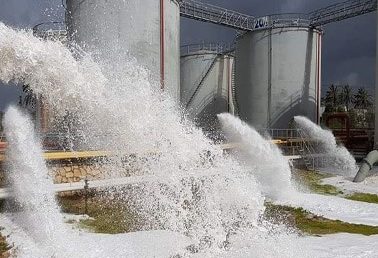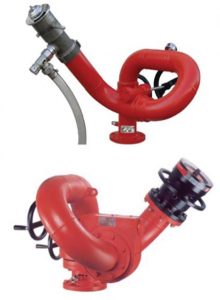Firefighting foam systems are used to suppress severe fires, especially those caused by flammable or combustible liquids.
Firefighting foam is stored in tanks as foam concentrate. When needed, the foam concentrate is first mixed with water in a specific ratio determined by the manufacturer using various methods to create a foam solution. The foam solution is then mixed with air in various ways to produce the foam that can be used for firefighting applications.

Types of firefighting foam
Over the years, various types of firefighting foam have been developed with different capabilities and for different applications. Some foams can float on the surface of flammable liquids and spread slowly. This creates a continuous layer on the surface of the liquid, which extinguishes the fire by separating the air from the combustible material and also by cooling it.
Other foams, after mixing with air, start to expand rapidly (up to 1000 times) and engulf all surrounding combustible materials. Some other foams are thick, paste-like and sticky, and when discharged through a nozzle, they can extinguish fires on three-dimensional and even vertical burning surfaces by forming a layer of foam. The types of firefighting foam used for different applications and combustible materials include:
- Protein foam: Protein foam concentrates are made from hydrolyzed natural proteins along with some stabilizers and other additives that are added to increase thermal stability, prevent reflash, and improve other properties. This type of foam does not have the ability to form a film on the surface of the burning liquid and must be used in conjunction with air aspirating nozzles.
- Fluoroprotein foam (FP): is essentially protein foam that has been augmented with fluorocarbon additives. Although the surface physical properties of fluoroprotein foam are improved, this type of foam also cannot form a film of aqueous film on the surface of hydrocarbon fuels.
- Synthetic foam: This type of foam is made from synthetic materials and is mainly used for fires involving Class B materials, such as flammable liquids and gases.
AFFF (Aqueous Film Forming Foam): This type of foam is a synthetic foam that forms a thin film on the surface of flammable liquids, preventing the release of vapors and smothering the fire. - Alcohol-resistant foam: This type of foam is specifically designed for fires involving alcohol-based fuels.
- High-expansion foam: This type of foam can expand up to 1000 times its original volume, making it ideal for large-scale fires.
- Class A foams: Firefighting foam is typically used to extinguish Class B fires. To use foam for Class A fire protection, foam suitable for this class of fire must be used. This type of foam is specifically designed to suppress Class A fires (caused by the burning of ordinary solids such as wood, paper, coal, plastic, rubber, etc.).
The choice of firefighting foam depends on a number of factors, including the type of fire and equipment, the combustible materials involved, and the size of the fire.
Firefighting foam systems are usually designed and installed according to NFPA 11 reference standard.
Methods of mixing foam concentrate with water
As mentioned earlier, in order to form foam that can be used in firefighting systems, the foam concentrate and water must first be mixed at a specific ratio. The resulting solution is then sent through a piping network to the discharge equipment and from there discharged onto the area of interest.
There are various equipment and methods for mixing water and foam concentrate, some of the most important of which are described below.
Bladder Tank
A bladder tank is typically made of a metal pressure vessel with an elastomeric (rubber) membrane or bladder inside. In this tank, the inside of the rubber bladder is filled with foam concentrate and the outer wall of this membrane is in contact with the flowing water stream. This configuration keeps the foam and water separate inside the tank. When the fire suppression system is activated, the water pressure compresses the rubber bladder and the foam is discharged through the outlet. The discharged foam is then mixed with water through a calibrated proportional orifice (Proportioner) to create a foam solution. The foam solution is then directed to the desired outlets through a piping network.

The bladder tank system does not require any external pumps or electric or mechanical motors to mix the foam with water. The energy required for this is provided solely by the pressure of the firefighting water flow. This system also does not require a separate foam storage tank.
Typically, a bladder tank system consists of the following components and equipment:
- Bladder tank with Proportioner
- Foam discharge outlets (such as foam nozzle, Foam Chamber, Pourer, etc.)
- Piping network between the water storage tank and the discharge nozzles
- Other equipment related to fire detection and activation of the fire extinguishing system
Foam Dosing System:
The proportioning system of foam and water by a water driven pump proportioner, which is more commonly known as foam dosing, consists of a positive displacement pump that receives its power mechanically from the energy of the firefighting water flow. In fact, in this system, the water flow causes the turbine and the related pump to start moving, which is responsible for injecting foam into the water at a specific concentration. In this system, the foam concentrate must be stored in separate atmospheric tanks.
This system does not require any external motor and performs the mixing of foam and water using only the energy of the water flow.

Typically, a bladder tank system consists of the following components and equipment:
- Atmospheric storage tank for storing foam concentrate
- Dosing system
- Foam discharge outlets (such as foam nozzle, Foam Chamber, Pourer, etc.)
- Piping network between the water storage tank and the discharge nozzles
- Other equipment related to fire detection and activation of the fire extinguishing system
Foam system applications
Foam fire extinguishing systems can be used to extinguish fires in a variety of ways, both manually and automatically. Some of the most common applications include:
- Foam monitors
- Foam handline
- Fixed surface systems (Fixed roof and floating roof storage tanks)
- Subsurface application

Foam Monitors:
Firefighting foam monitors can be used manually to protect process areas in oil, gas and petrochemical industries, fuel tanks, or any similar location where there is a potential for a high volume of liquid fuel to leak or catch fire. Water/foam monitors are available in fixed or portable types and can be used to discharge large volumes of foam onto a fire.
It is important to note that according to NFPA 11, firefighting water/foam monitors should not be used as the primary means of protection for fixed-roof tanks with a diameter greater than 18 meters (60 feet). In other words, in these conditions, an automatic foam system should be used and a monitor can be used in conjunction with it.

Hand hose and nozzle (Foam Handline):
The logic of using foam firefighting hoses is similar to that of using monitors for extinguishing tank fires. In this regard, it should be noted that according to NFPA 11, manual hoses and nozzles should not be used as the primary means of firefighting for tanks with a diameter greater than 9 meters or a height greater than 6 meters. However, firefighting foam hand nozzles play a vital role in extinguishing large tank fires as a supplementary fire protection system. A firefighting nozzle with a flow rate of 50 gpm (190 lpm) is very effective in suppressing small flames around tanks. The reaction force applied to the operator usually limits the maximum flow rate to 1135 lpm (300 gpm).
Fixed foam systems on the surface (fixed and floating roof tanks)
One of the methods for protecting fuel tanks is to use fixed foam spreading systems on the surface of the liquid inside the tank. For this purpose, two types of output devices are defined, which are:
Type I Outlet: This is a type of foam discharge device that spreads foam slowly over the surface of the liquid so that the foam does not penetrate or mix with the liquid. This type of outlet is no longer used in new systems.
Type II Outlet: This type of outlet also spreads foam slowly over the surface of the liquid, but it is designed to limit the penetration of foam into the liquid or the mixing of foam and flammable liquid. A foam chamber is an example of this device, which is installed above the tank and above the liquid level.
The minimum number and required flow rate for outlets is determined by the type of fuel, the diameter of the tank, and the NFPA 11 standard.


Subsurface application system
Another method used to protect fixed-roof tanks is subsurface foam injection. In this method, the discharge nozzle is usually installed near the bottom of the tank, but above the level of any possible water accumulation. It is important to note that many hydrocarbon fuels are insoluble in water and are lighter than water.
In this method, the expanded foam is injected from below the tank at a controlled rate. The buoyancy of the foam causes it to rise slowly to the surface of the liquid and spread there.
This method cannot be used where:
- For protection against Class IA hydrocarbon liquids
- For protection against polar solvents
- This method is not recommended for protection of open top tanks or covered floating roof tanks.
In this system:
The foam solution is mixed with air by a high back pressure foam maker outside the dike area and produce foam. In this case, the expansion ratio is usually 4:1.
- Expanded foam is introduced from the foam maker to the opening of the tank, which is above the water level of the tank, through the piping whose size is calculated carefully According to NFPA 11, foam velocity at the point of discharge to the tank shall not exceed 3 m/s (10 ft/s) for Class IB liquids and 6 m/s (20 ft/s) for other liquids. Higher velocity may cause turbulence in the foam flow and mix it with the combustible material.
- The foam moves towards the surface of the tank due to buoyancy

